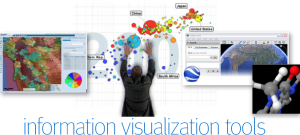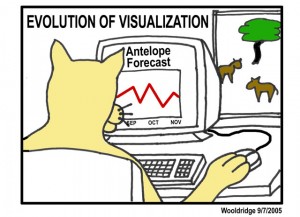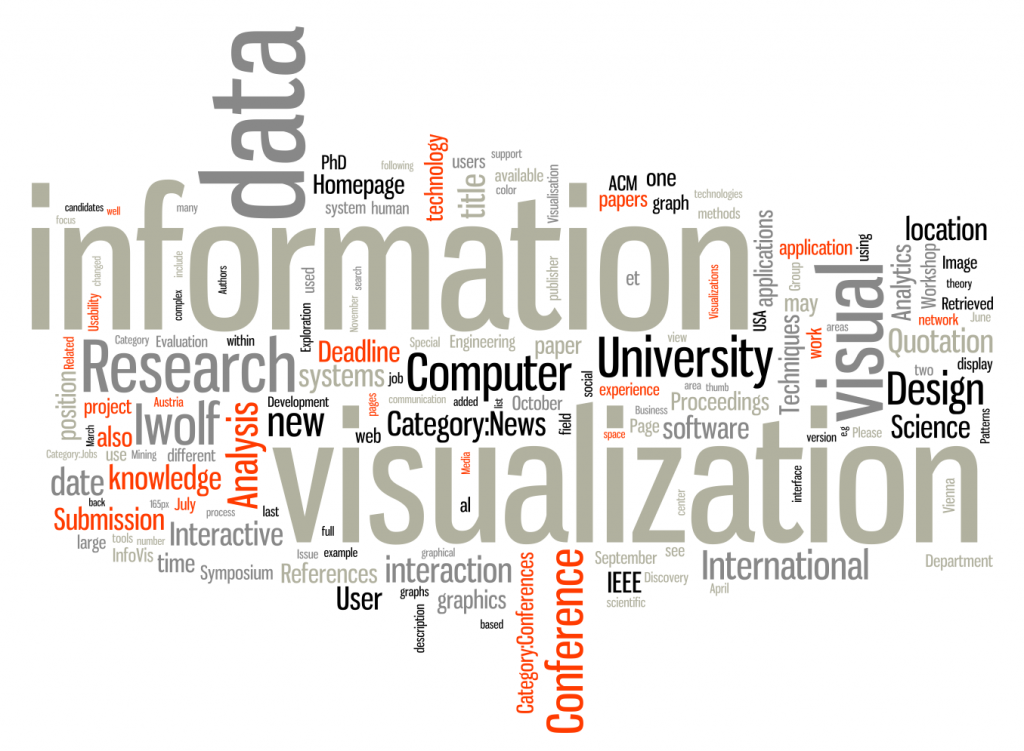Knowledge Representation & Information Visualization in the 21st Century Classroom
What is KR & Infovis all about and why do I care?
Knowledge representation: often referred to as being part of AI and ability for machines to compute. It is, for our purposes, referring to how knowledge can be represented in science and maths as models, graphical displays of quantitative relationships and intuitive visual organizers.
Information visualization: is the visual representation of qualitative and/or quantitative data most often in simulations and models.
Both knowledge representation and infovis can be effective components of a quality science or math program of study. The use of computer-supported, interactive, visual representations of abstract data to amplify cognition is one method to engage learners in developing higher thinking skills. Infovis has data as its root but the ultimate goal is discovery, decision making, hypothesizing, problem solving, inquiry and exploration where the infovis process converts data to information in order to generate insight. Dominique Brodbeck, Riccarde Mazza, and Denis Lalanne (2009) explain the efficacy of infovis in these terms: “Visual representation transforms a cognitive problem into a perceptual task, which is drastically more efficient”. As educators we need to understand the significance of KR and infovis because maths and science often has teachers presenting knowledge in unique and different approaches. Technology is catalyzing the way in which we are able to do this for and with our students. Using models and simulations allows us to guide students to participate in KR and infovis using highly effective and exciting tools.
We know that models can represent events, processes and systems and we can use these to prove or refute our students’ existing internal cognitive representations. Why is this important? Khan (2007) describes how our mental models are influenced by the environment, our community and interactions with technology and artefacts and with infovis students are able to generate evaluate and modify these pre-existing cognitive notions. Using models and simulations enables students to manipulate all kinds of variables that they could never do in real life, challenging misconceptions and often promoting a necessary cognitive disturbance. Schwarz, Meyer, & Sharma (2007) discuss how computer modelling and simulation software represent data and phenomena “in ways that can help predict and explain those phenomena, often by visually representing abstract components and causal relationships over time. The importance of such software can be seen by observing the central role computational modelling plays in such aspects as forecasting the weather, analyzing atomic and molecular structure, determining the physics of the early universe, and understanding human reasoning. Further, educational versions of such software enable students and teachers to visualize and develop reasoning about abstract scientific concepts and phenomena, access cutting-edge scientific research, engage in authentic practices of science—and do so in interesting ways” (p.2). As a result, using models can contextualize scientific and mathematical concepts and make meaning for students.
Infovis is likely particularly constructive for less able students, visual and kinaesthetic learners and mathematical-spatially intelligent individuals. Zhang, Wu, Fretz, Krajcik & Soloway (2001) state that students do not need to write exact, complicated equations to specify the relationship between two quantities. In fact, they believe that students have the ability and opportunity to identify the relationship between two objects either quantitatively or qualitatively without computation. This means that students can construct models quickly and easily focusing their “attention on the tasks of analyzing, causal reasoning, testing and re-examining their models.” (p.6)
Web 2.0 and open source software are making the use of infovis more and more feasible in schools. In addition, a computer with accompanying software would likely be less expensive that conducting the actual experiment/investigation in ‘real time’. This can lead to greater productivity and more exposure to certain types of problem based learning activities where students are afforded with an opportunity to test and re-test their self-created hypotheses.
What about Model It? What are the cognitive affordances and/or social opportunities?
When using infovis tools students can create their own models of the phenomena that they explore directly, enabling complex concepts to be learned. Model-It is such a tool: a learner-centred tool for building qualitative based models which can test student generated hypotheses. It enables learners to build dynamic models of scientific phenomena based on a prediction or problem scenario, and then observe the results in simulations and the graphical output. Schwarz, Meyer, & Sharma (2007) articulate that effective model software can show something that cannot normally or easily be observed while enabling student manipulation of the data. One drawback of Model It is that although it promotes the creation of relationships between variables and to make relationships between variables it does not have a feature that can assess the accuracy of those relationships (Schwarz, Meyer, & Sharma. 2007).
Model-It is visual and provides an intuitive interface where the students can plan (select the factors to be involved in the model), build (identify variables and describe relationships) and test (observe the simulation) their models. (Krajcik, 2000) Model It is a good digital tool for knowledge representation as it allows students to determine relationships between two objects either qualitatively or quantitatively without having to do complex computations. This enables learners to focus on analysis and modification of their models as needed (Zhang, Wu, Fretz, Krajcik & Soloway. 2001). The relationship editor allows students to chose the relationships between their variables within their model- they can increase and decrease the independent variables using the sliding scale on the meters which consequently enables them to see the changes in the ‘real time’ line graph. This feature is what lets students evaluate their models and make modifications (Zhang, Wu, Fretz, Krajcik & Soloway. 2001). I think Model It enabled us to:
- pick the data, variables and identify the relationships
- test our predictions which ultimately helped us visualize knowledge
- analyse data, relate reasoning and synthesize ideas
- visualize abstract components, and causal relationships over time
- become engaged in a scientific process leading to mathematical skills development
- use it alongside solid pedagogical strategies such as TGEM, the 5Es and POE
- meet the needs of a diverse student body- challenging those who need extension and allowing scaffolding for those who need it
Model It is about visualizing and embodying theories of abstract concepts or ideas into models, gathering information and data from simulations and models, and testing those models.” (Schwarz, Meyer, & Sharma. 2007). It would be particularly useful for models about:
- pollution- air, water, land, acid rain or sick buildings
- global climate change
- food webs, predator-prey relationships and ecosystems
- communicable diseases
- watershed issues
- decomposition
- soil erosion
Depending on how a teacher designs the learning activity for Model It, the software has many social opportunities:
- students can work in pairs or groups to use the software
- they can check their results with other students and identify problems
- different scenarios/problems could be given to students based on their ability groups
- asynchronous- so can be completed over time, or parts done independently as homework with pair-group follow ups
- screenshots of results could be shared via synchronous tools allowing discussion and co-creation of conclusions or new hypotheses
How can I use KR & IV in Model It?
| Teacher as designer: | Active Roles for the students… |
| Problem Based Learning scenarios to be investigated | Students are given a complex problem based scenario and use the affordances of Model It to investigate |
| Criteria given by teachers- student predict results | Teacher demonstration- students and teacher input together into the model BUT the students all write down their prediction independently first |
| Results provided by teacher- students try to generate the variables | Students know the results and try to recreate the test (object, variables and relationships) to generate the same results à process oriented |
| Scenario given- results to be analysed | Students are given a scenario or problem and independently or in pairs simulate the problem and analyse the results |
| TGEM- teacher selects issue | T- use Model ItG- generate a hypothesisE- use the model to test the hypothesisM- modify the test if the results don’t make sense |
| 5 Es- teacher designs a lesson (like the one Darren and I made) | Students are:Engaged with a video or game about the topicExplore- the topic with research or a teacher demo of the model- then run the test in the model themselvesExplain- analyse and explain the resultsEvaluate- identify if the results make sense- yes=make a conclusion, no=re-hypothesise and re-testElaborate- create graph by hand, research a variable of the test, make a poster to warn of the consequences etc. |
| Self Directed model: teacher provides certain success criteria only- ie. must have __ objects, __independent variable, __ dependent variables, __ relationships etc. | – student picks problem, selects appropriate # of variables, makes prediction, observes and explains (POE) |
Does Infovis work?
According the John Hattie’s synthesis of over 800 meta-analyses (2009) simulations can improve low-level achievement, for example, recall of facts, understanding scientific processes, application of scientific knowledge to real life and some more profound outcomes such as problem solving and development of higher-order thinking skills. The research also indicated that the simulations were more effective for the less able students and for shorter interactions rather than longer interactions. Interestingly, a significant proportion of his research indicated that the effects on achievement were small ({Vansickle, 1986, Remmer & Jernsted, 1982 and Armstrong, 1991}) however, I believe it is important to note that this is outdated research and the simulations used in these studies may not have the impactful knowledge representation, information visualization and interactive affordances that we have access to today.
Schwarz, Meyer, & Sharma (2007) indicate that although models allow “students to make relationships between variables [they do] not assess the accuracy of those relationships” (p.16). Also, although visualizations can support a learner’s understanding of scientific/mathematical concepts, there is a possibility for the learner to develop misconceptions if the activity is too far beyond their ZPD. The challenge for teachers lies in the design of the learning activity. The technology can motivate learners but the task needs to be at a suitable level to develop understanding and minimize misconceptions.
References:
Brodbeck, Dominique, Mazza, Riccarde, & Lalanne, Denis. (2009). Interaction visualization: A survey. In Denis Lalanne, & Jürg Kohlas (Eds.), Human Machine Interaction (pp. 27–46). Berlin: Springer-Verlag.
Enhancing Education: The 5 Es. (2002). http://enhancinged.wgbh.org/research/eeeee.html
Hattie, J. 92009). Visible Learning: A synthesis of over 800 meta-analyses relating to achievement. Routledge, New York.
Khan, S. (2007). Model-based inquiries in chemistry. Science Education, 91(6), 877-905. Retrieved from http://onlinelibrary.wiley.com/doi/10.1002/sce.20226
Krajcik, Joseph. (2000). Model It, Visualization Tools. DPD website. http://www.edu-design-principles.org/dp/viewFeatureDetail.php?feKey=273
Schwarz, C., Meyer, J. & Sharma, A. (2007). Technology, pedagogy, and epistemology: Opportunities and challenges of using computer modeling and simulation tools in elementary science methods. Journal of Science Teacher Education, 18, 243-269.
Schwarz, C.,Reiser, B.J., Davis, E.A., Kenyon, L., Acher, A., Fortus, D.,Shwartz, Y.,Krajicik, J., (2009). Developing a Learning Progression for Scientific Modeling: Making Scientific Modeling Accessible and Meaningful for Learners, Journal of Research in Science Teaching, 46 (6), 632-645
Zhang, B., Wu, H., Fretz, E., Krajcik, J., & Soloway, E. (2001, March). Exploring middle school students’ modeling process and cognitive strategies when using a computational modeling tool. Paper presented at the Annual Meeting of the National Association for Research on Science Teaching (NARST), St. Louis, Missouri. Full-text document retrieved on November 24, 2011 from http://citeseer.ist.psu.edu/viewdoc/summary?doi=10.1.1.24.5954
Zhang,B., Liue,X., & Krajcik, J.S. (2006). Expert models and modeling processes associated with a computer-modeling tool. Science Education, 90, 579-604. Available UBC online.


